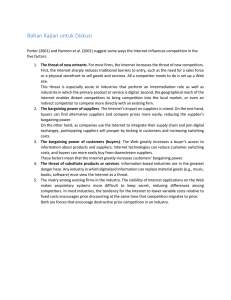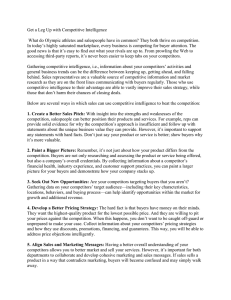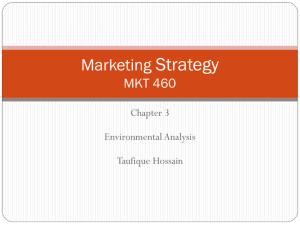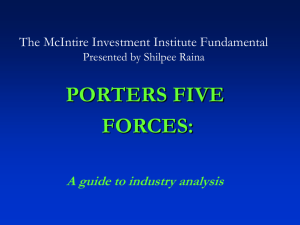Strategic Management 5e. (Hill & Jones)
advertisement
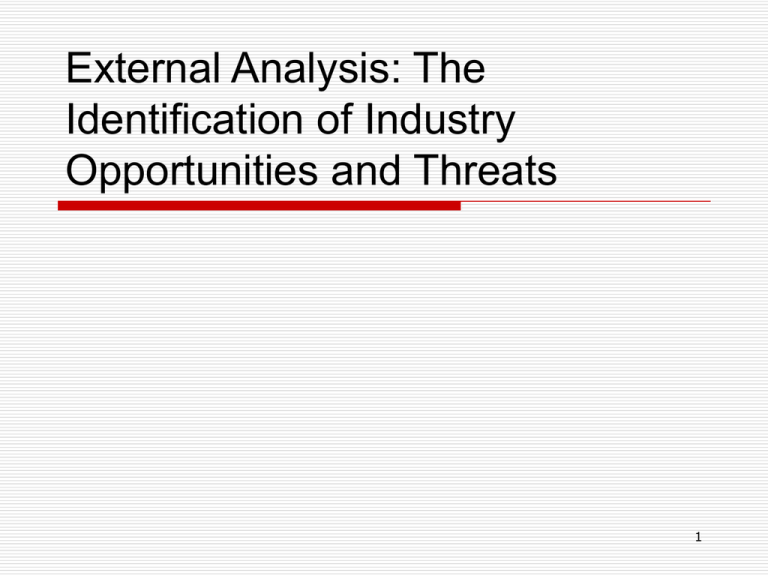
External Analysis: The Identification of Industry Opportunities and Threats 1 The Environment Macro-environment Trends and events that affect all firms (albeit in different ways) Micro-environment Trends and events that affect a particular firm or set of firms Traditional focus on industry analysis E.g. airline industry, computer industry, banking industry Issues in determining the boundary of an industry 2 Sectors, industries, segments… 3 SCP Paradigm Structure Conduct Performance Michael Porter (1980) e.g. Concentration e.g. Collusion 4 The Five Forces Model 5 Potential Competitors New entrants into an industry threaten incumbent companies. Barriers to entry: Brand loyalty Absolute cost advantages Economies of scale Switching costs Government regulation Entry barriers reduce the threat of new and additional competition. 6 Rivalry Among Established Companies The intensity of competitive rivalry in an industry arises from: Industry’s competitive structure. Demand (growth or decline) conditions in industry. Height of industry exit barriers Investment in specialized assets High fixed costs of exit Emotional attachments to an industry 7 The Bargaining Power of Buyers Buyers are most powerful when: There are many small sellers and few large buyers. Buyers purchase in large quantities. A single buyer is a large customer to a firm. Buyers can switch suppliers at low cost. Buyers purchase from multiple sellers at once. Buyers can easily vertically integrate to compete with suppliers. 8 The Bargaining Power of Suppliers Suppliers have bargaining power when: Their products have few substitutes and are important to buyers. The buyer’s industry is not an important customer to the supplier. Differentiation makes it costly for buyers to switch suppliers. Suppliers can vertically integrate forward to compete with buyers and buyers can’t integrate backward to supply their own needs. 9 Substitute Products The competitive threat of substitute products increases as they come closer to serving similar customer Far Close needs. 10 The implications of five forces model It makes it possible to diagnose the competitive forces and characterize the position of a company. To a large extent, the forces influences the rules of the game of the competitors and the strategies which are potentially available. To an extent, it determines the profit potential of the industry. 11 A Sixth Force: Complementors Complementors: Companies whose products are sold in tandem with another company’s products. Increased supply of a complementary product collaterally increases demand for the primary product. Concept of co-opetition Example: Faster CPU chips fuel sales of personal computers. 12 Exercise In groups of 3-5, perform a five forces model on an industry with which you are familiar Is it an attractive industry? Why/why not? 13 The Role of the Macroenvironment 14 Macroenvironment Macroeconomic: e.g. growth rate of the economy, interest rates, currency exchange rates, and inflation rates Technological: e.g. Internet Social: Greater health consciousness (e.g. diet) Demographic: General aging of population in U.S. and some other countries Political: e.g. change of the administration Legal: e.g. Anti-Trust 15 Dynamic industry analysis Trends (PEST) Events Strategies Alter industry forces over time Possible to trace past, present, and future evolution of an industry 16 Strategic Groups Within Industries The concept of strategic groups Within an industry, a competitor grouping using similar strategies that differ from other industry groups. Implications of strategic groups The closest industry competitors are those in the group. The various industry groups are differentially and competitively advantaged and positioned. Mobility barriers inhibit the movement of competitors from one strategic group to another. 17 Strategic Groups in the Pharmaceutical Industry 18 Honda Question In 1977 my MBA final exam on the Honda Motorcycle case asked “Should Honda enter the global automobile business?” It was a “giveaway” question. Anyone who said “yes” flunked. Markets were saturated Efficient competitors existed in Japan, the U.S.,and Europe Honda had little or no experience in automobiles Honda had no auto distribution system In 1985 my wife drove a Honda --Richard Rumelt, Professor at UCLA 19 Location-based Competitive Advantage (CA of Nations) 20 Globalization and Industry Structure Globalization Globally dispersed production lowers costs and increases quality. Global markets are replacing national markets. Trend implications No isolated national markets More competitors, more intense competition More rapid innovation and shorter product life cycles 21

